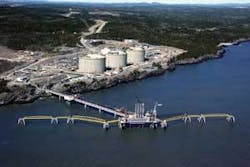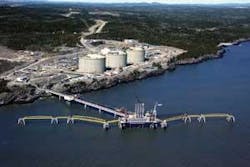The 2009 LNG outlook is grim, according to a recently published review of global LNG by FACTS Global Energy, Singapore.
FGE authors Nelly Mikhaiel and Siamak Adibi say that supply gluts, an economic malaise depressing energy demand, and plunging petroleum prices characterize global markets.
In Asia, current LNG demand is sluggish, while a year ago its markets needed a steady supply of Atlantic Basin LNG. This year, Asian cargoes are likely to be seeking markets west of Suez.
Those markets, however, evince “indifferent energy demand” as well as a fresh new slug of LNG supply coming online by yearend to exacerbate already saturated global markets.
Demand
Weak economic growth in Asia will depress LNG demand in the region to 112 million tonnes in 2009, nearly 5% off demand in 2008, says the FGE report.
Japan, perennially the world’s largest LNG importer, will lead the way. Japanese utility companies, says the analysis, have all but eliminated all spot purchases for 2009. The country’s imports, therefore, will be around 62 million tonnes, down 10%, from 2008. Imports for 2010 will recover to around 64 million tonnes.
For Korea, which traditionally comes in second in global LNG imports, overall gas consumption will decrease by about 6%. As a result, 2009 Korean LNG imports will fall by an estimated 7%, compared with 2008, to 25.6 million tonnes.
Spot 2009 Korean imports will be “virtually nil,” say the report’s authors, until possibly autumn when the traditional storage filling season begins in advance of winter.
In China, despite the effects of financial recession, long-term contracts will nonetheless bring more LNG into the country. The 2.6-million tonnes/year (tpy) Fujian LNG terminal will by mid-year begin receiving shipments from Indonesia’s much-delayed Tangguh project. A pipeline explosion at the Shanghai terminal, China’s third, has pushed commissioning back to at least yearend 2009. Malaysia LNG (Tiga) is to supply the terminal under long-term contracts.
The study also notes that India could attract cargoes unwanted by Japan, Korea, and Taiwan. Its import levels, say the authors, are closely linked to natural gas prices: The lower the prices, the more India can import. The country’s shorter distance from Pacific Rim and Mideast LNG exporters would be an attraction and make LNG competitive with naphtha and some domestic gas.
What is clear, say the FGE authors, is that “India has the potential to reduce the amount of LNG that some analysts expect to be delivered to the Atlantic Basin” from mid-2009 on.
European LNG demand this year will increase only marginally from 2008. Gas and power players will need to replenish low storage levels, a “hangover from the Russia-Ukraine pipeline dispute this past winter.”
That demand will be augmented by start-up of new UK LNG terminal capacity as well as additional supply. Previously troubled production in Algeria and Nigeria are likely to recover, says the report, supplemented by new supply from Qatar that targets Europe and the US.
North America
Forecasts of US LNG imports for 2009 are for about 7.4 million tonnes, rising to 9.4 million tonnes in 2010. But those projections are subject to considerable uncertainty, say the authors, about how much LNG tanker traffic can be expected into US ports during the next 18 months.
US industrial gas demand, expected to fall by 6% in 2009, will more than offset small projected increases in other sectors. And US gas storage injections are running ahead with ample gas still in storage. Many observers, the report states, are anticipating a major gas glut in 2009.
But the US is the “home of choice” for LNG volumes unwanted by Asia and even Europe. Although Henry Hub’s current price levels yield less than attractive netbacks for exporters, the market “remains deep enough to absorb LNG cargoes unwanted elsewhere–assuming, or course, that LNG exporters are willing to accept the returns.”
In addition to about 68 million tonnes of existing LNG import capacity, North America will commission this year at least three new terminals with a combined import capacity of more than 33 million tpy–Cameron, La. (Sempra), Golden Pass, Tex. (Port Arthur, Tex.), and Canaport (St. John, NB; photograph). More capacity will follow in 2010.
The authors note that counterseasonal South American gas demand may take some load off saturated North American LNG markets. Official Brazilian gas demand calls for more than 5 million tpy of LNG imports for the next couple of years. Brazil will have about 5.5 million tonnes of import capacity when its second offshore LNG terminal at Guanabara Bay is completed later this year (OGJ, Mar. 16, 2009, p. 64).
Chile will become an LNG importer this year. A consortium led by Chilean state-owned petroleum company ENAP will begin commissioning its 2.5-million tpy terminal at Quintero Bay in June. Plateau demand from this terminal is 1.7 million tpy. A second, 1.4-million tpy Chilean terminal at Mejillones owned by GDF Suez and copper producer Codelco should also complete construction by 2009, with start-up slated for January 2010.
Supply
Global nameplate liquefaction capacity will grow to about 240 million tonnes by yearend 2009, an increase from its 2008 level of about 197 million tonnes. “Naturally, these projects will take some time to ramp up to their respective nameplate capacities, and actual production will be somewhat less,” the report says.
Most of new LNG export capacity slated for 2009 start-up is in the Middle East. Two regional export projects will begin exports by yearend: more than 30 million tonnes of capacity in Qatar and another 6.7 million tonnes in Yemen.
Asia will also add to its LNG production capability with the recent start-up of Train 1 of the Sakhalin II project (4.8 million tpy; OGJ Online, Mar. 31, 2009), and Train 2 may come online a few months later, as well as Indonesia’s soon-to-be-inaugurated two-train, 7.6-million tpy Tangguh project and completion of Malaysia LNG Dua’s debottlenecking.
The Atlantic Basin, on the other hand, will not inaugurate any new production capacity this year.
Few FIDs
LNG players today, says the report, are “living in a time of falling gas demand, plunging prices, and a world awash with LNG.” But the slight amount of additional LNG supply coming on line over the next few years should “quell any speculation that the pendulum is swinging from a seller’s to a buyer’s market again.”
While FGE assumes no further delays in new projects under construction and expected online in 2009-12, there could be a drop-off in new capacity additions for 2012-13. After all, the report says, only five projects have reached an affirmative final investment decision since 2006–Algeria’s Arzew GLZ3 and the Skikda rebuild; Angola LNG; Australia’s Pluto LNG, and Peru LNG.
Combined, these represent only 23 million tpy of greenfield capacity, less than a quarter of how much had been approved in the preceding 3 years. “This translates to modest capacity increases in the medium term,” says the report.
While affirmative FIDs are likely this year for Gorgon (Australia) and Donggi (Indonesia), uncertain demand prospects and doubt over the future direction of engineering and construction costs may encourage prospective LNG exporters to exercise caution, say the authors. This “waiting game spells bad news for buyers looking for additional LNG supplies” to bridge their forecast post-2012 demand-supply gaps.
Similar LNG supply trends hold for 2010. The Middle East will commission more Qatari megatrains (Qatargas 3 and 4), while the Pacific Rim will see Peru LNG and Australia’s Pluto come online.
The Atlantic Basin will not bring online any new production capacity for 2010. The next regional contributor to the region’s capacity will be the single-train 5.2-million tpy Angola LNG project, not scheduled for cool-down until 2012.


